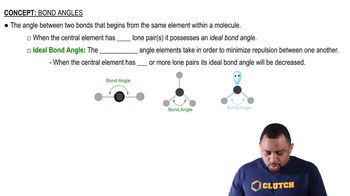Sodium azide is a shock-sensitive compound that releases N2 upon physical impact. The compound is used in automobile airbags. The azide ion is N3-. (b) State the hybridization of the central N atom in the azide ion.

Butadiene, C4H6, is a planar molecule that has the following carbon–carbon bond lengths:

(a) Predict the bond angles around each of the carbon atoms and sketch the molecule.
 Verified step by step guidance
Verified step by step guidance
Verified video answer for a similar problem:
Key Concepts
Hybridization

Bond Angles

Resonance Structures

In ozone, O3, the two oxygen atoms on the ends of the molecule are equivalent to one another. (d) How many electrons are delocalized in the p system of ozone?
Butadiene, C4H6, is a planar molecule that has the following carbon–carbon bond lengths:
(b) From left to right, what is the hybridization of each carbon atom in butadiene?
Butadiene, C4H6, is a planar molecule that has the following carbon–carbon bond lengths:
(c) The middle C¬C bond length in butadiene (1.48 Å) is a little shorter than the average C¬C single bond length (1.54 Å). Does this imply that the middle C¬C bond in butadiene is weaker or stronger than the average C¬C single bond?
The structure of borazine, B3N3H6, is a six-membered ring of alternating B and N atoms. There is one H atom bonded to each B and to each N atom. The molecule is planar. (a) Write a Lewis structure for borazine in which the formal charge on every atom is zero.
